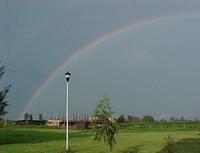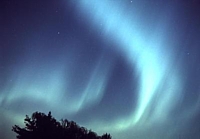Below are some of the best-known phenomena of this type, which are usually caused by the natural influence of the atmosphere (and the chemical elements that compose it), or represent "plays of light" that can deceive or give the appearance of something that is not what it seems. These phenomena are quite beautiful and worth photographing if you have the opportunity to do so.
Rainbow
 It is one of the most well-known and beautiful phenomena that occur in the sky. They occur when, during a rainy day, raindrops act as mirrors that disperse light in all directions, breaking it down and forming the rainbow. This is formed with the Sun's rays that impact the drops and are dispersed at an angle of ~138º, forming the arc; The ray of light enters the drop, refracting, then moving towards its opposite end and reflecting on its internal face, to finally refract when leaving the drop as decomposed light; Rainbows usually last up to 3 hours, and are always seen in the opposite direction from the Sun.
It is one of the most well-known and beautiful phenomena that occur in the sky. They occur when, during a rainy day, raindrops act as mirrors that disperse light in all directions, breaking it down and forming the rainbow. This is formed with the Sun's rays that impact the drops and are dispersed at an angle of ~138º, forming the arc; The ray of light enters the drop, refracting, then moving towards its opposite end and reflecting on its internal face, to finally refract when leaving the drop as decomposed light; Rainbows usually last up to 3 hours, and are always seen in the opposite direction from the Sun.
dawn
 They are phenomena produced at latitudes close to the Earth's magnetic poles, as they are produced through the interaction of the latter with the particles carried by the Sun's solar wind. When the particles reach the Earth, they impact against the molecules of the upper atmosphere and Therefore they excite (ionize) them, a fact that produces the well-known glow of the auroras. These are known as northern or southern lights, depending on the hemisphere where they are seen. Normally auroras can only be seen at latitudes above 65º (e.g. Alaska, Canada), but during periods of high solar activity (such as solar storms), they can even be seen from lower latitudes, around 40º. These phenomena can last around 1 hour, or all night if it is during a period of high activity.
They are phenomena produced at latitudes close to the Earth's magnetic poles, as they are produced through the interaction of the latter with the particles carried by the Sun's solar wind. When the particles reach the Earth, they impact against the molecules of the upper atmosphere and Therefore they excite (ionize) them, a fact that produces the well-known glow of the auroras. These are known as northern or southern lights, depending on the hemisphere where they are seen. Normally auroras can only be seen at latitudes above 65º (e.g. Alaska, Canada), but during periods of high solar activity (such as solar storms), they can even be seen from lower latitudes, around 40º. These phenomena can last around 1 hour, or all night if it is during a period of high activity.

